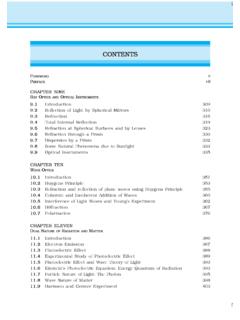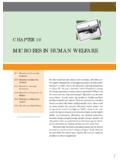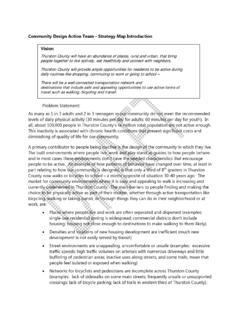Transcription of Introduction to Maps - Prashanth Ellina
1 1 Introduction to MapsChapter 1 Introduction to MapsYou may be familiar withmaps that you have seen inmost of your books of socialsciences representing theearth or any of its may also know that theshape of the earth is geoid(three-dimensional) and aglobe can best represent it(Fig. ). A map, on theother hand, is a simplifieddepiction of whole or partof the earth on a piece ofpaper. In other words, it isa two-dimensional form ofthe three-dimensionalearth. Hence, a map can bedrawn using a system ofmap projections (seeChapter 4). As it is impossible to represent all features of the earth ssurface in their true size and form, a map is drawn at a reducedscale. Imagine your school campus. If a plan/map of your school isto be drawn in its actual size, it will be as large as the campus , maps are drawn at a scale and projection so that each pointon the paper corresponds to the actual ground position.
2 Besides,the representation of different features is also simplified usingsymbols, colours and shades. A map is, therefore, defined asselective, symbolised and generalised representation of whole or aFigure India as it is seen on the globe2 Practical Work in GeographyGlossaryCadastral Map : A large-scale map drawn at a scale of 1 : 500 to 1 : 4000 to show propertyboundaries, designating each parcel of land with a Points : North (N), South (S), East (E) and West (W).Cartography : Art, science and technology of making maps, charts, plans and other modesof graphical expression as well as their study and : A simplified representation of the features on the map, appropriateto its scale or purpose, without affecting their visual : An oblate spheroid whose shape resembles the actual shape of the : A selective, symbolised and generalised representation of the whole or part of theearth at a reduced series : A group of maps produced at same scale, style and specifications for a countryor a : The system of the transformation of the spherical surface onto a : The ratio between the distances of two points on the map, plan or photograph andthe actual distance between the same two points on the Map.
3 A simplified map drawn freehand which fails to preserve the true scale Sketch of the Environs of Delhi (Left) and a Map of Delhi (Right)3 Introduction to Mapspart of the earth's surface on a plane surface at a reduced scale. It mayalso be understood that a simple network of lines and polygons withouta scale shall not be called a map. It is only referred to as the sketch (Fig. ). In the present chapter, we will study the essential requirementsof maps, their types and the OF MAP MAKINGIn view of the variety of maps, we may find it difficult to summarisewhat they all have in common. Cartography, being an art and science ofmap-making, does include a series of processes that are common to allthe maps. These processes that may also be referred to as essentials ofmaps are : Scale Map Projection Map Generalisation Map design Map Construction and ProductionScale: We know that all maps are reductions.
4 The first decision that amap-maker has to take is about the scale of the map. The choice of scaleis of utmost importance. The scale of a map sets limits of informationcontents and the degree of reality with which it can be delineated on themap. For example, figure provides a comparison between maps havingdifferent scales and the improvements made thereupon with the changein : We also know that maps are a simplified representationof the three-dimensional surface of the earth on a plane sheet of transformation of all-side-curved-geoidal surface into a plane surfaceis another important aspect of the cartographic process. We should knowthat such a radical transformation introduces some unavoidable changesin directions, distances, areas and shapes from the way they appear ona geoid.
5 A system of transformation of the spherical surface to the planesurface is called a map projection. Hence, the choice, utilisation andconstruction of projections is of prime importance in Work in GeographyA Portion of Sheet NH 43 A Portion of Sheet 53 H A Portion of Sheet 53 H/2 A Portion of Guide MapFigure Effect of Scale on Mapped Information5 Introduction to MapsGeneralisation: Every map is drawn with a definite objective. Forexample, a general purpose map is drawn to show information of a generalnature such as relief, drainage, vegetation, settlements, means oftransportation, etc. Similarly, a special purpose map exhibits informationpertaining to one or more selected themes like population density, soiltypes or location of industries. It is, therefore, necessary to carefullyplan the map contents while the purpose of the map must be kept in theforefront.
6 As maps are drawn at a reduced scale to serve a definitepurpose, the third task of a cartographer is to generalise the mapcontents. In doing so, a cartographer must select the information (data)relevant to the selected theme and simplify it as per the design : The fourth important task of a cartographer is the mapdesign. It involves the planning of graphic characteristics of mapsincluding the selection of appropriate symbols, their size and form, styleof lettering, specifying the width of lines, selection of colours and shades,arrangement of various elements of map design within a map and designfor map legend. The map design is, therefore, a complex aspect of map-making and requires thorough understanding of the principles thatgovern the effectiveness of graphic Construction and Production: The drawing of maps andtheir reproduction is the fifth major task in the cartographic process.
7 Inearlier times, much of the map construction and reproduction workused to be carried out manually. Maps were drawn with pen and inkand printed mechanically. However, the map construction andreproduction has been revolutionalised with the addition of computerassisted mapping and photo-printing techniques in the recent OF MAP MAKINGThe history of map making is as old as the history of mankind itself. Theoldest map was found in Mesopotamia drawn on a clay tablet that belongsto 2,500 Figure shows Ptolemy s Map of the World. Greek andthe Arab geographers laid the foundation of modern cartography. Themeasurement of the circumference of the Earth and the use of the systemof geographical coordinates in map-making are some of the significantcontributions of the Greeks and the Arabs.
8 The art and science of map6 Practical Work in Geographymaking was revitalised in earlymodern period, with extensiveefforts made to minimise theeffects of the transformation ofthe geoid onto a plane maps were drawn on differentprojections to obtain truedirections, correct distances andto measure area accurately. Theaerial photography supplementedthe ground method of survey andthe uses of aerial photographsstimulated map-making in thenineteenth and foundation of map-making in India was laid during the Vedicperiod when the expressions of astronomical truths and cosmologicalrevelations were made. The expressions were crystallised into sidhantas'or laws in classical treaties of Arya Bhatta, Varahamihira and Bhaskara,and others. Ancient Indian scholars divided the known world into seven dwipas (Fig.)
9 Mahabharata conceived a round world surroundedby water (Fig. ).Todarmal pioneered landFigure Seven Dwipas of the World as conceived in Ancient IndiaFigure Round World surrounded by water as conceived in MahabharataFigure Ptolemy s Map of the World7 Introduction to Mapssurveying and map-making as an integral part of the revenue collectionprocedure. Besides, Sher Shah Suri s revenue maps further enrichedthe mapping techniques during the medieval period. The intensivetopographical surveys for the preparation of up to date maps of theentire country, were taken up with the setting up of the Survey of Indiain 1767, which culminated with the map of Hindustan in 1785. Today,the Survey of India produces maps at different scales for the of Maps Based on Scale: On the basis of scale, maps maybe classified into large-scale and small-scale.
10 Large scale maps are drawnto show small areas at a relatively large-scale. For example, thetopographical maps drawn at a scale of 1: 250,000, 1:50,000 or 1:25,000and the village maps, the zonal plans of the cities and house plansprepared on a scale of 1:4,000, 1:2,000 and 1:500 are large scale the other hand, small-scale maps are drawn to show large example, atlas maps, wall maps, etc.(i) Large-scale Maps: Large-scale maps are further divided into thefollowing types :(a) Cadastral maps(b) Topographical maps(a) Cadastral Maps : The term cadastral is derived from the Frenchword cadastre meaning register of territorial property . These maps aredrawn to show the ownership of landed property by demarcating fieldboundaries of agricultural land and the plan of individual houses inurban areas.



















